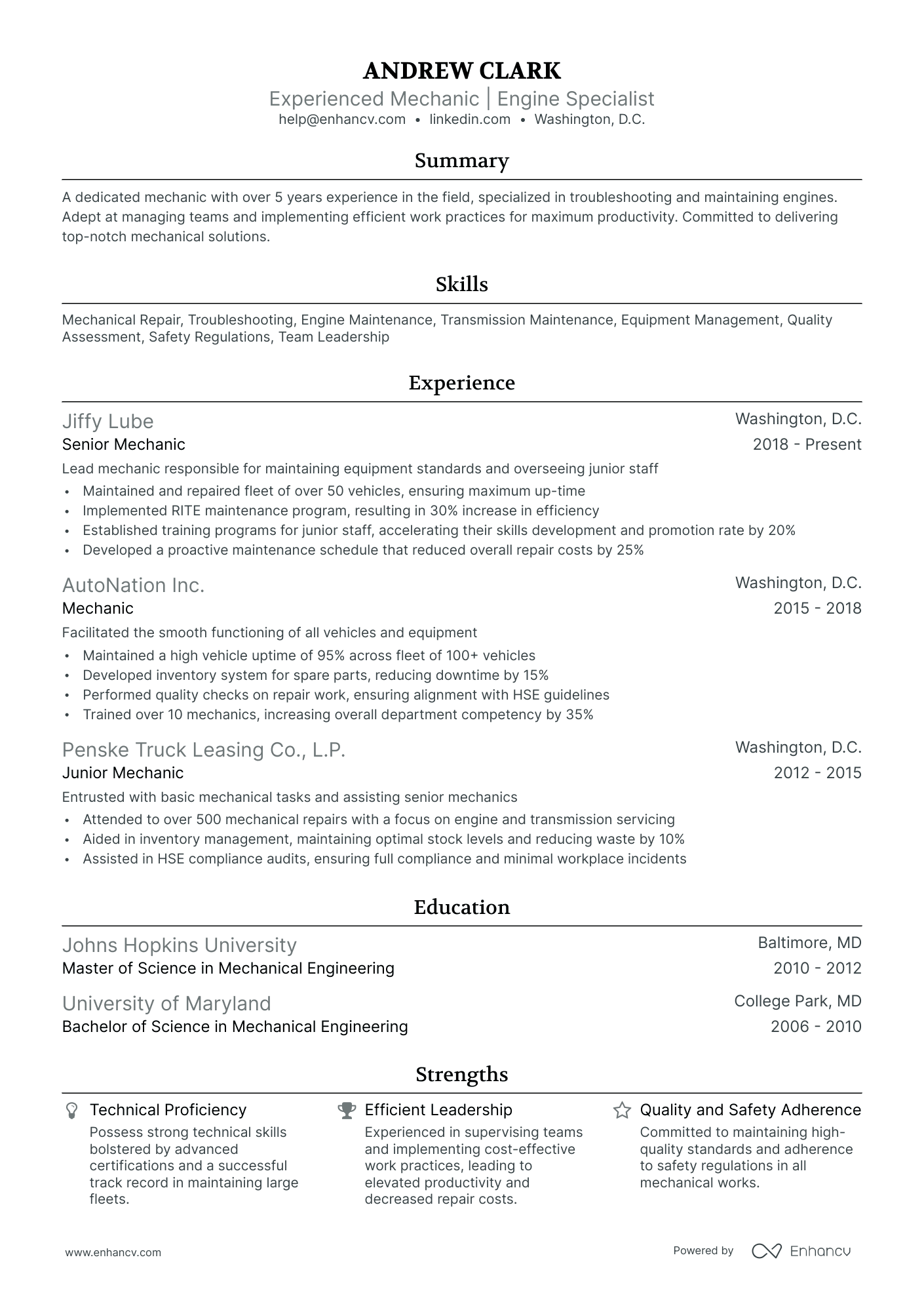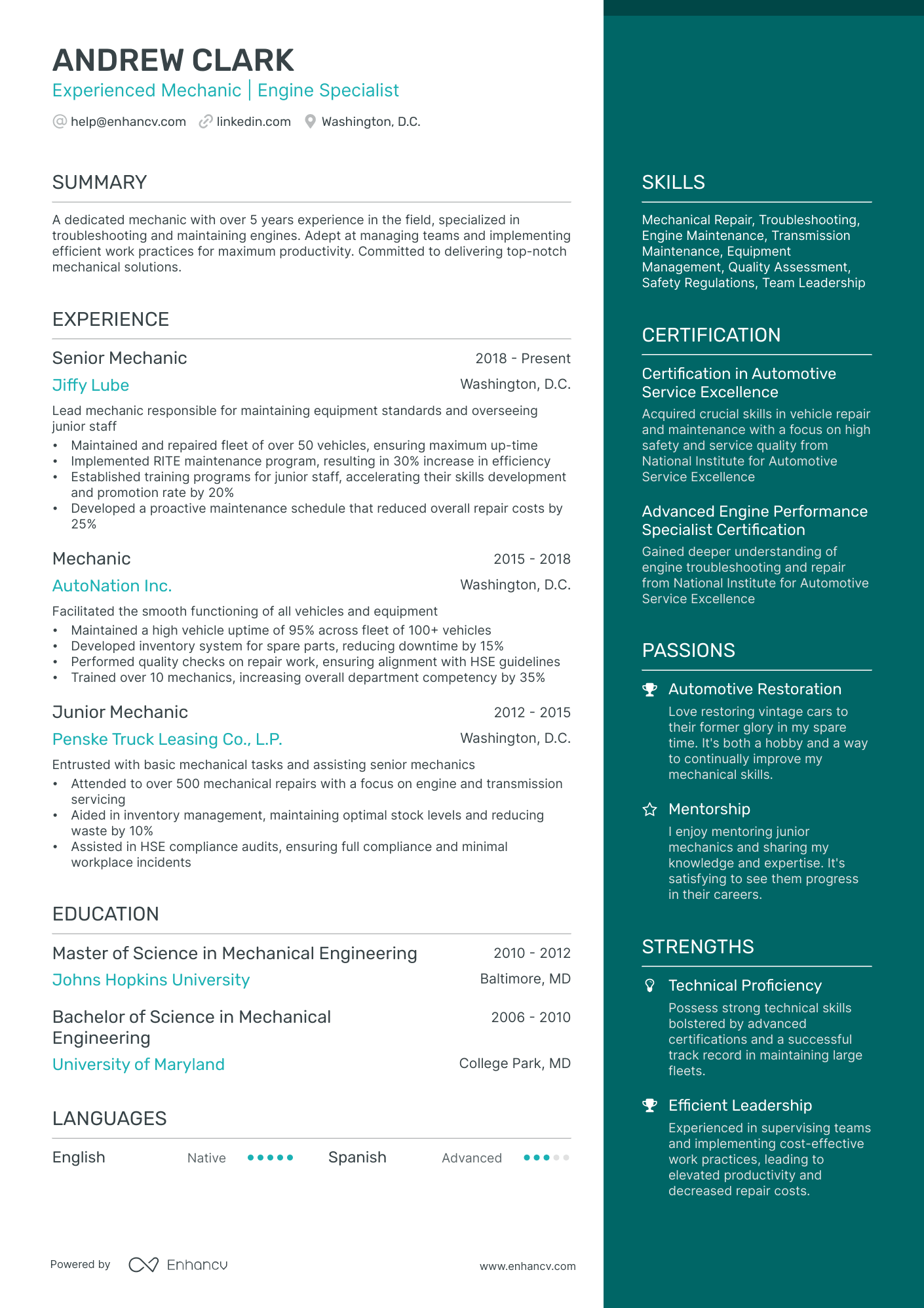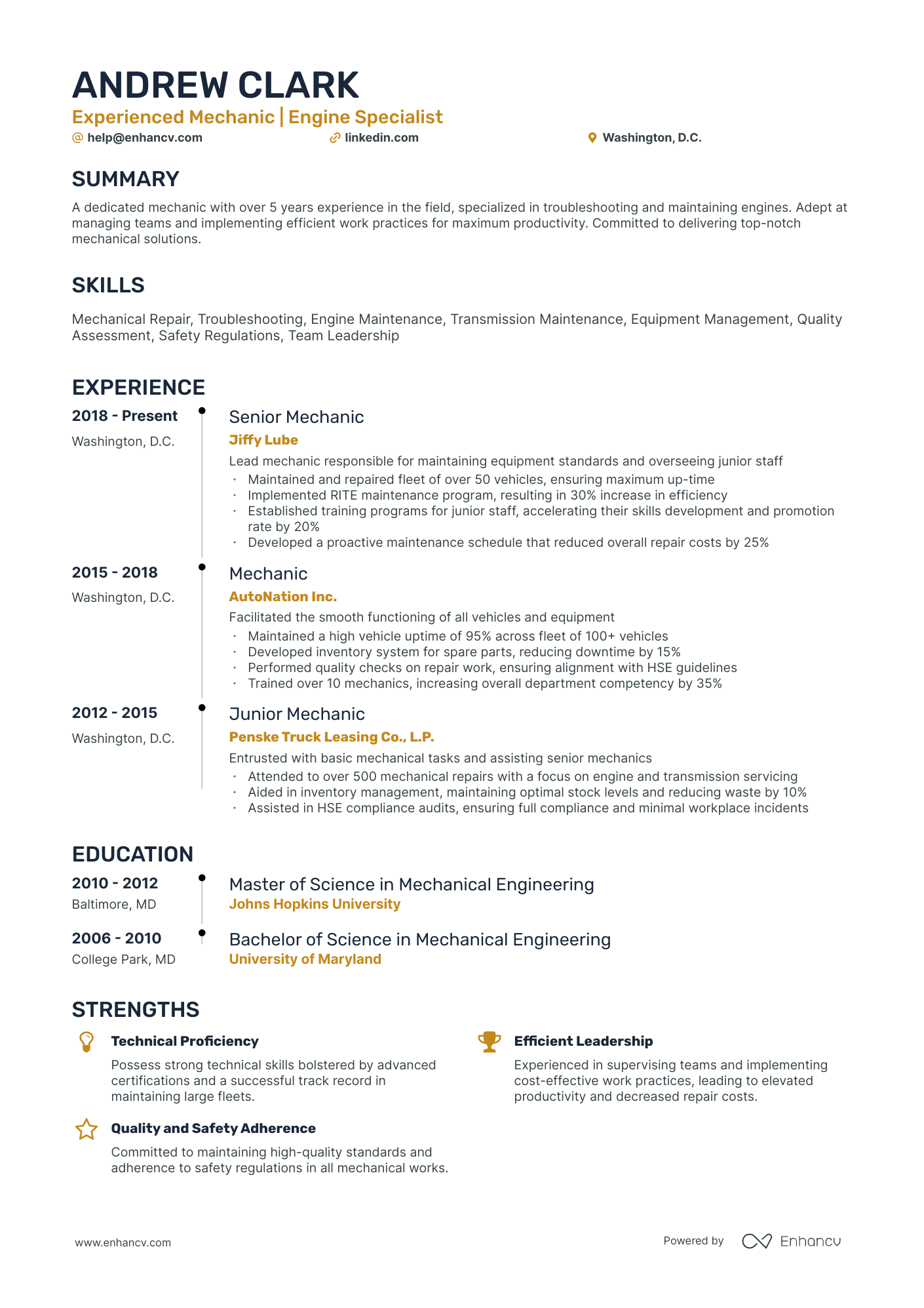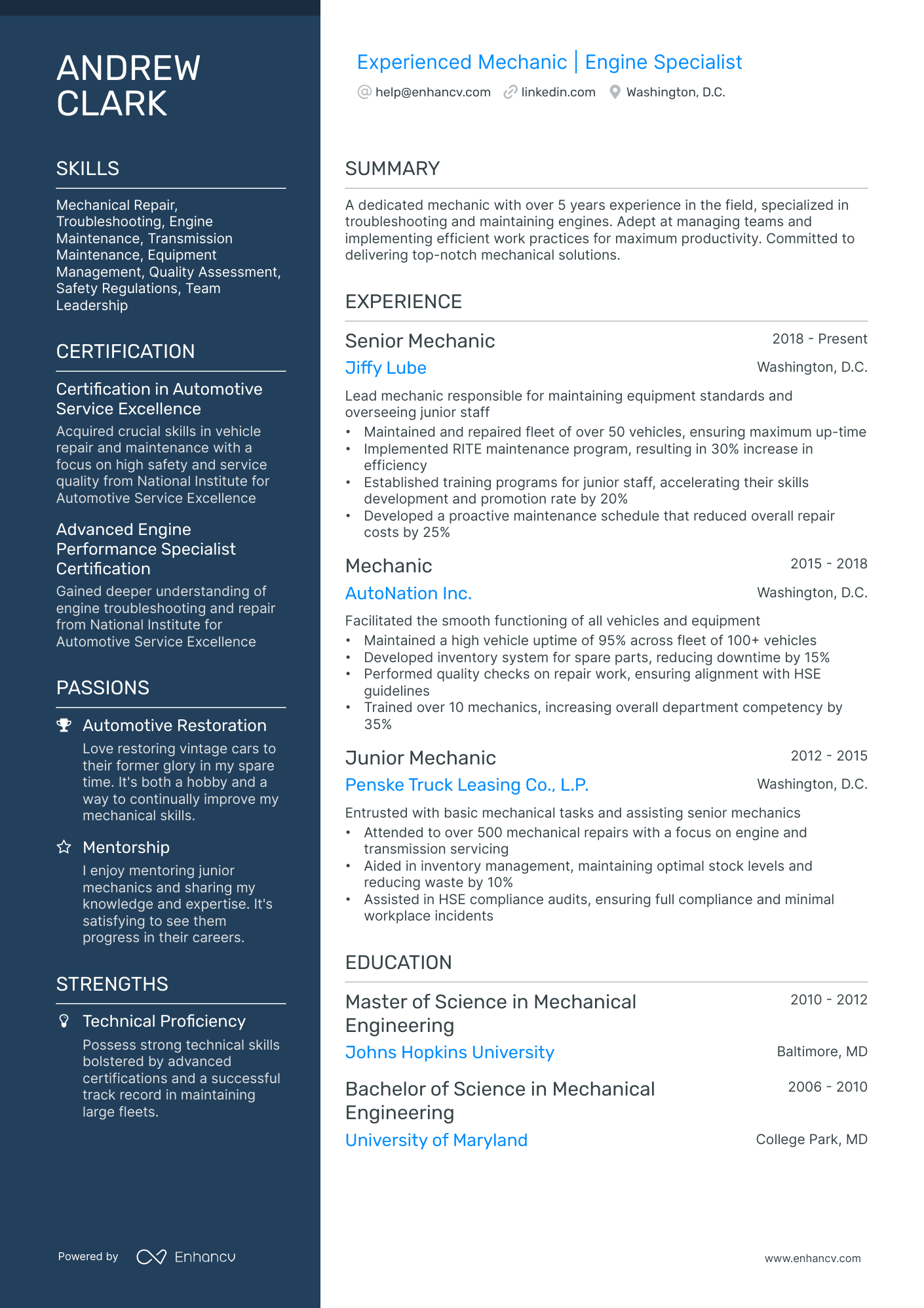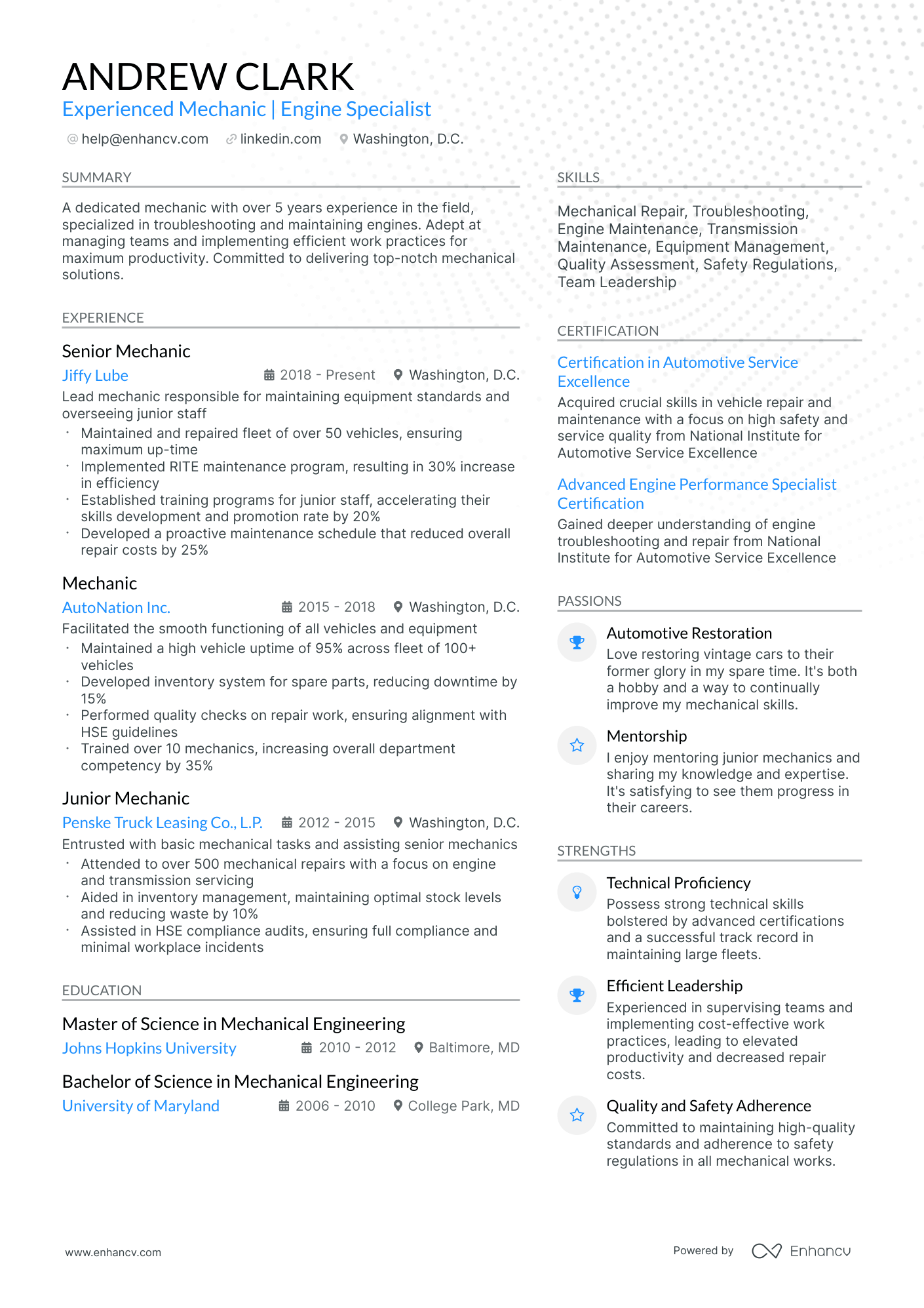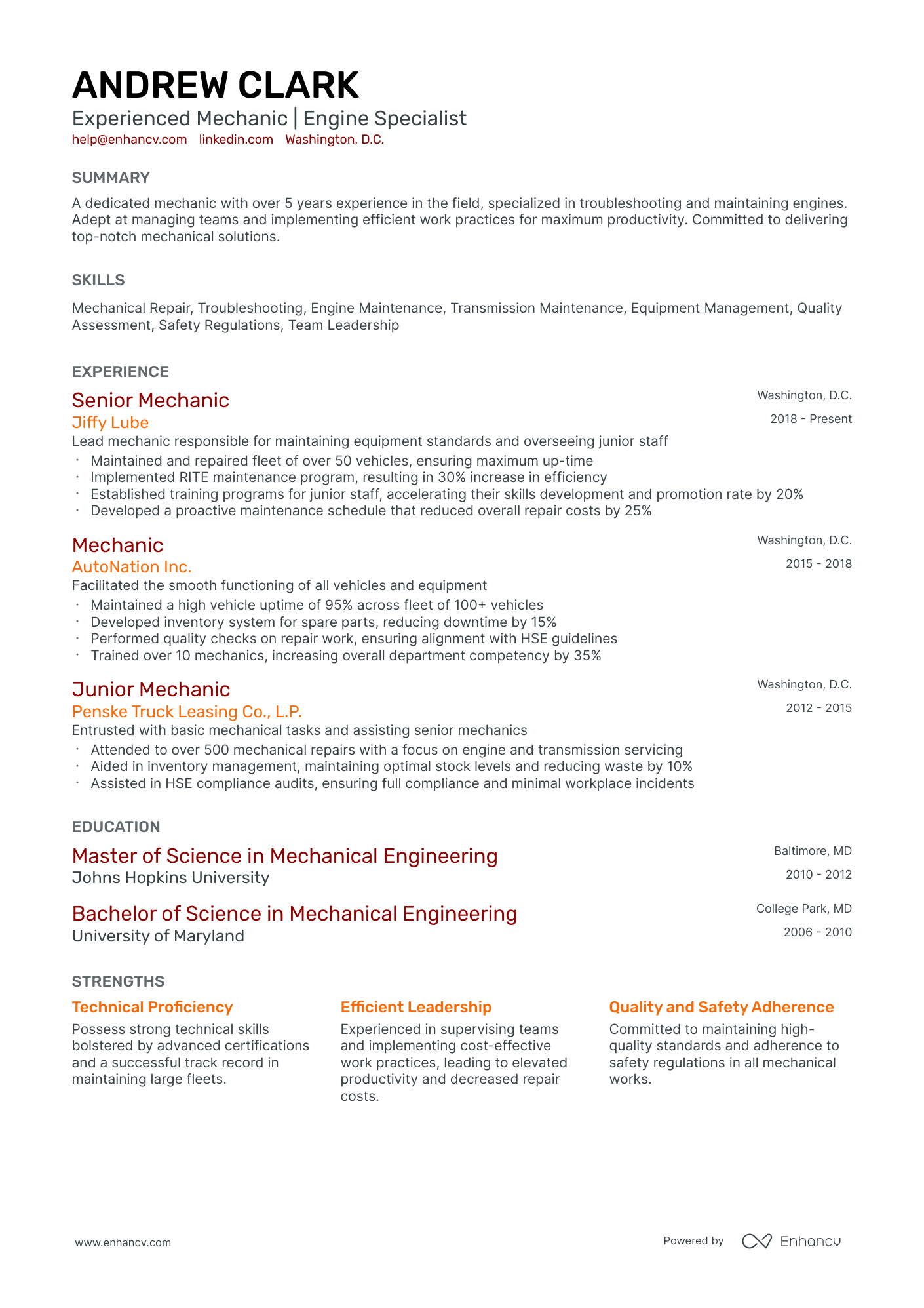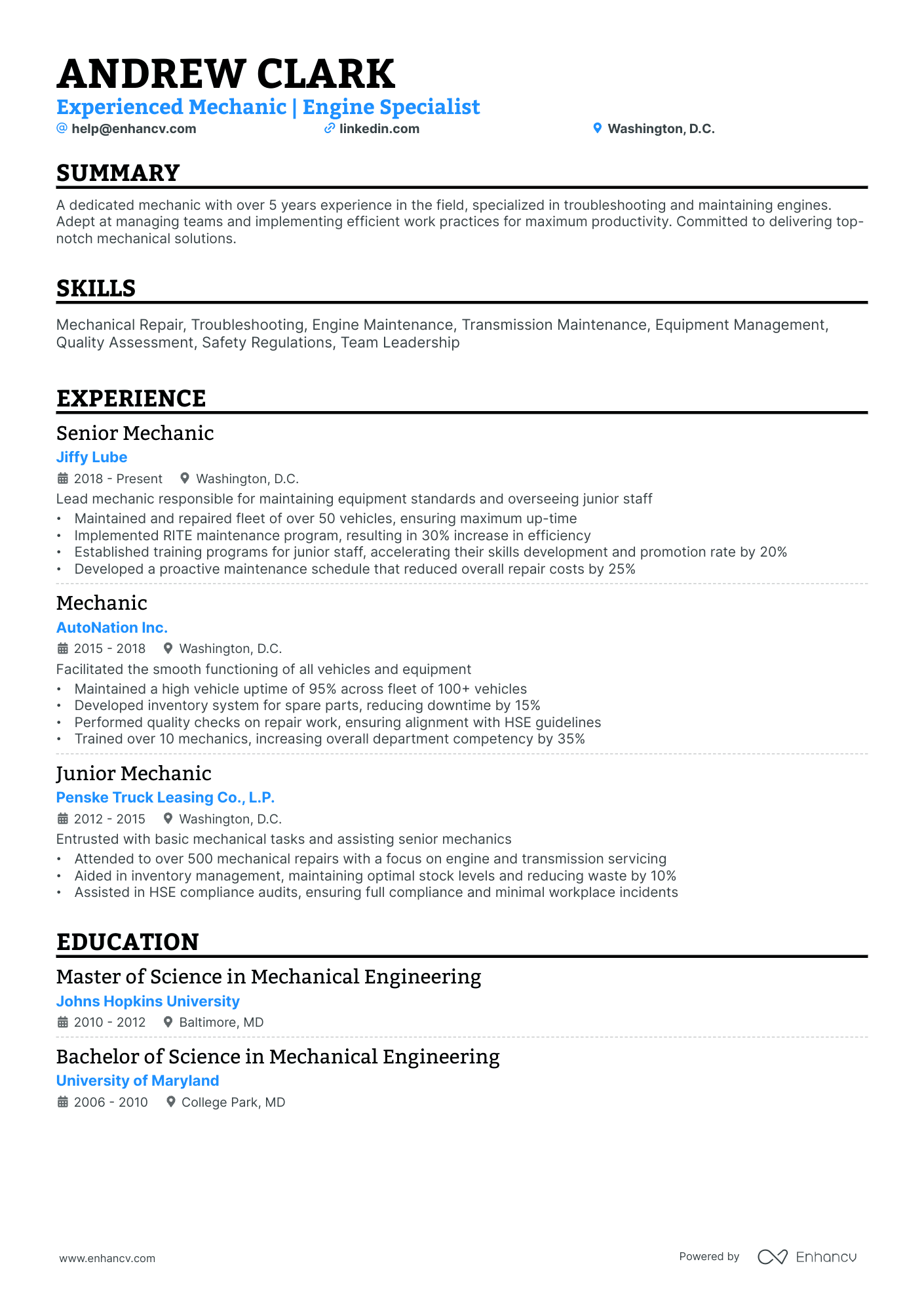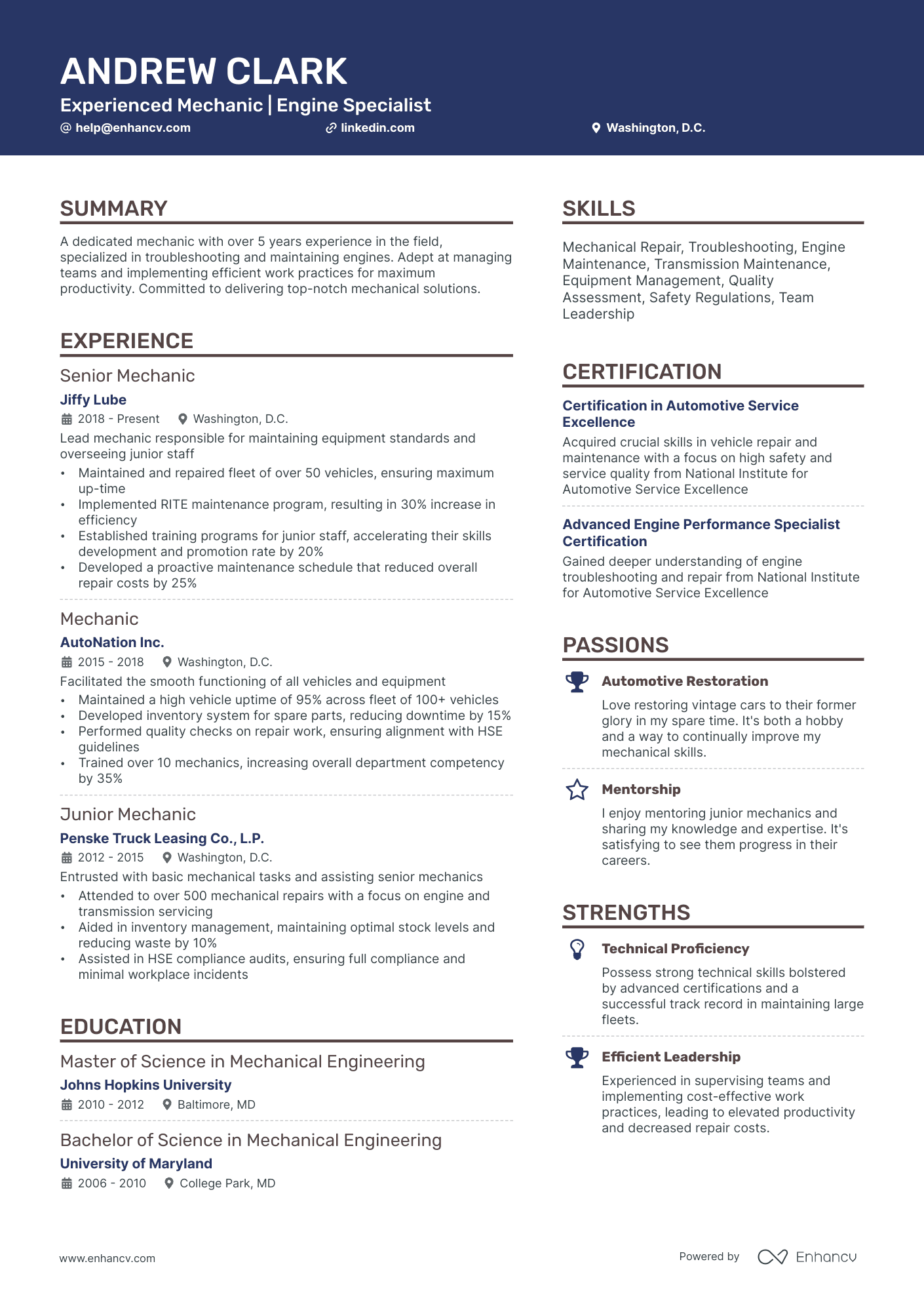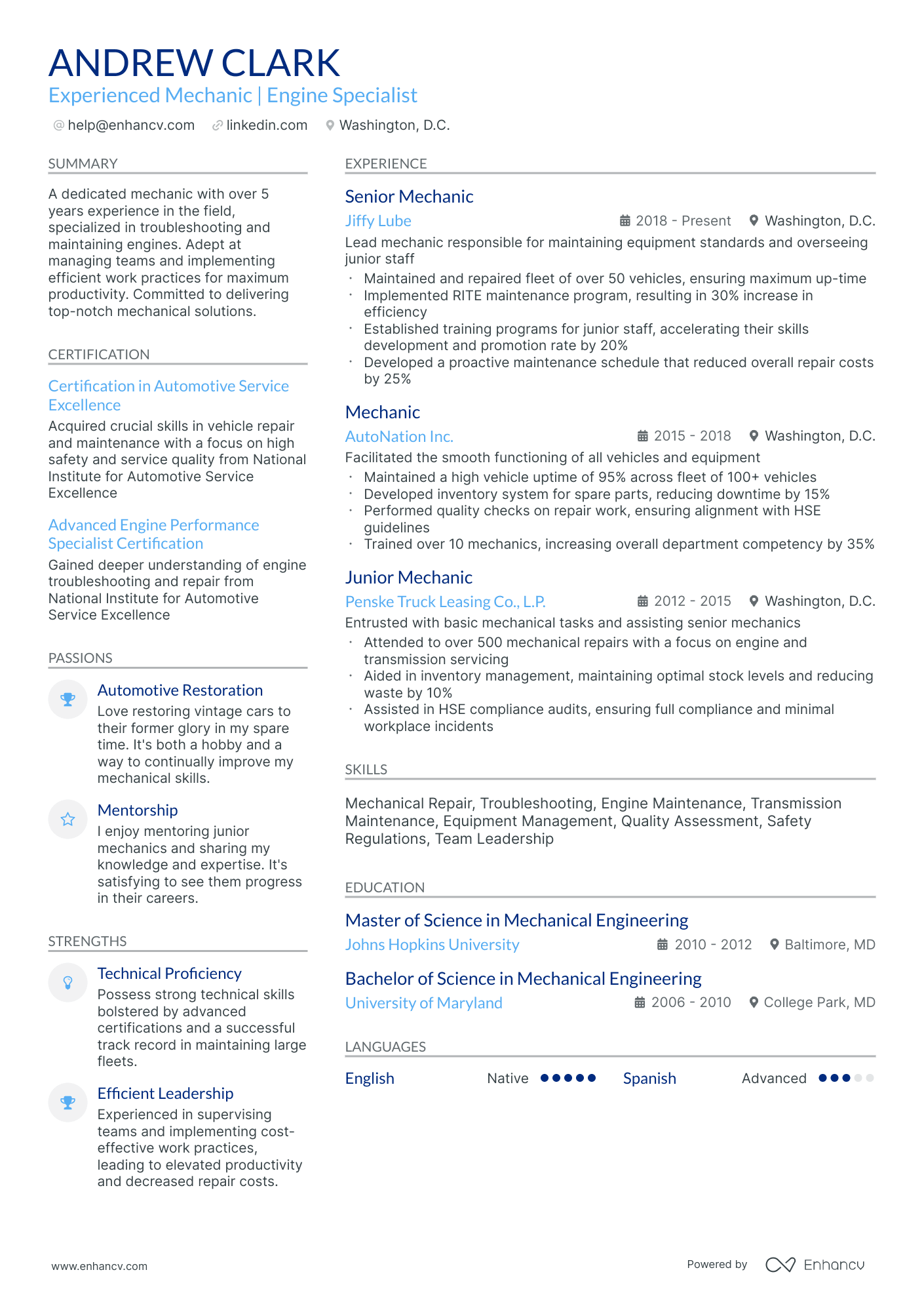One key challenge faced by maintenance mechanics when crafting their resumes is effectively showcasing their blend of technical skills, practical experience, and problem-solving abilities in a clear and concise manner. Our guide can assist with this issue by providing specific examples and templates on how to highlight these complex competencies, hence creating a compelling narrative that demonstrates your value to potential employers.
Dive into this guide to learn how to craft a maintenance mechanic resume that offers recruiters a clear view of your career journey:
- Draw from our maintenance mechanic resume samples, highlighting top skills, certifications, and more.
- Illuminate the potential impact you can bring to an organization through your resume summary and experience.
- Spotlight your unique maintenance mechanic expertise, emphasizing tangible results and standout achievements.
Recommended reads:
Deciphering the best format for your maintenance mechanic resume
To craft an impactful maintenance mechanic resume, start by thoroughly analyzing the job description.
Your chosen resume format should seamlessly align your experience with the role's requirements.
Consider these four pivotal elements:
- Present your experience effectively. If you boast a wealth of pertinent experience, employ the reverse-chronological resume format, listing roles by date, beginning with the most recent.
- Maintain brevity. Limit your resume to a maximum of two pages, focusing on your most salient attributes.
- Headers serve a purpose. A well-crafted header ensures recruiters can swiftly access your contact details and professional portfolio.
- Opt for PDF. Typically, submit your maintenance mechanic resume in PDF to preserve its layout. However, always adhere to specific job application guidelines.
Your resume should match the market – Canadian applications, for instance, may use a different layout.
Upload your resume
Drop your resume here or choose a file. PDF & DOCX only. Max 2MB file size.
Pro tip
Choose a legible, professional font for your maintenance mechanic resume, such as Arial or Calibri.
Recruiters' top picks for maintenance mechanic resume sections:
- A header with essential contact details and a headline showcasing your current role.
- A summary or objective that aligns your standout expertise with the role's demands.
- An experience section that delves into your key responsibilities and achievements.
- A skills section that intertwines job requirements with your unique capabilities.
- Education and certifications sections that bolster your professional credentials.
What recruiters want to see on your resume:
- Professional certification and training in maintenance mechanics, such as an Industrial maintenance mechanic certification or equivalent.
- Proven experience in troubleshooting, maintaining, and repairing industrial machines and equipment.
- Proficiency in using tools related to maintenance work including power tools, diagnostic instruments, and knowledge of automation systems.
- Understanding and adherence to safety regulations and procedures, plus any record of low accident rates.
- Strong problem-solving skills and the ability to work under pressure during emergency breakdowns or urgent repairs.
Recommended reads:
Detailing your relevant experience on your maintenance mechanic resume
Showcase your credibility in the resume experience section. For an effective maintenance mechanic resume:
- Highlight measurable achievements.
- Scan the job advert for keywords and integrate them throughout your experience section.
- Emphasize your technical proficiencies and how you've applied them in various roles.
- Keep it simple: mention your responsibility, relevant skills, and the outcomes.
- Use this section to convey your unique value, soft skills, feedback received, and the type of company culture you thrive in.
Top professionals ensure their experience section offers a captivating look at their expertise. Check out our sample maintenance mechanic resumes for guidance.
- Performed preventive maintenance on industrial machinery resulting in a 20% reduction in equipment breakdowns.
- Diagnosed and repaired electrical and mechanical issues, minimizing production downtime by 30%.
- Collaborated with a team to install and commission new production lines, ensuring smooth operations.
- Conducted routine inspections and implemented corrective actions, improving machine efficiency by 15%.
- Maintained accurate documentation for all maintenance activities, ensuring compliance with regulatory standards.
- Executed major equipment overhauls, resulting in a 25% increase in equipment lifespan and reduced replacement costs.
- Implemented a computerized maintenance management system, streamlining work order processing and reducing response time by 40%.
- Provided technical support during equipment installations, resulting in a seamless transition and minimal disruption to production.
- Collaborated with cross-functional teams to troubleshoot and resolve complex machinery issues, reducing mean time to repair by 50%.
- Optimized equipment performance through regular calibration and adjustments, achieving a 10% increase in production output.
- Led a team of mechanics during critical maintenance shutdowns, ensuring timely completion and minimizing production losses.
- Implemented energy-saving initiatives resulting in a 15% reduction in overall electricity consumption.
- Developed and implemented a predictive maintenance program, reducing unplanned equipment downtime by 30%.
- Performed root cause analysis on equipment failures, leading to the implementation of effective preventive measures.
- Collaborated with engineering teams to design and fabricate custom tooling, improving efficiency and safety in production processes.
- Responded to emergency breakdowns promptly, minimizing production losses and ensuring minimal impact on delivery schedules.
- Conducted equipment upgrades and retrofits resulting in enhanced reliability and improved product quality.
- Trained junior maintenance staff on equipment troubleshooting techniques, contributing to their professional development.
- Implemented a preventive maintenance schedule that reduced unscheduled maintenance events by 20%.
- Identified and resolved electrical faults, resulting in a significant decrease in equipment malfunctions and downtime.
- Assisted in the installation and commissioning of automated systems, ensuring smooth production flow.
- Performed routine inspections and identified defective components, resulting in a 15% reduction in equipment failures.
- Collaborated with suppliers to source spare parts, reducing lead time for repairs and minimizing production interruptions.
- Implemented safety protocols and conducted training sessions, leading to a 30% decrease in workplace accidents.
- Developed and implemented equipment maintenance procedures, resulting in a 20% increase in equipment reliability.
- Analyzed equipment performance data and recommended improvements, optimizing overall production efficiency by 10%.
- Participated in equipment upgrades and retrofits, ensuring compliance with industry standards and enhancing productivity.
- Performed scheduled maintenance tasks on a wide range of machinery, minimizing unexpected breakdowns by 25%.
- Collaborated with cross-functional teams to develop and implement energy-saving initiatives, reducing operational costs by 15%.
- Assisted in the development of standard operating procedures, ensuring consistent and efficient maintenance practices.
The following content includes information from "O*NET OnLine" by the U.S. Department of Labor, Employment and Training Administration (USDOL/ETA). Used under the CC BY 4.0 license. The data represents the top responsibilities present on the task lists for maintenance mechanic professionals.
Top Responsibilities for Maintenance Mechanic:
- Use handtools, such as screwdrivers, pliers, wrenches, pressure gauges, or precision instruments, as well as power tools, such as pneumatic wrenches, lathes, welding equipment, or jacks and hoists.
- Inspect brake systems, steering mechanisms, wheel bearings, and other important parts to ensure that they are in proper operating condition.
- Raise trucks, buses, and heavy parts or equipment using hydraulic jacks or hoists.
- Adjust and reline brakes, align wheels, tighten bolts and screws, and reassemble equipment.
- Attach test instruments to equipment, and read dials and gauges to diagnose malfunctions.
- Perform routine maintenance such as changing oil, checking batteries, and lubricating equipment and machinery.
- Examine and adjust protective guards, loose bolts, and specified safety devices.
- Inspect, test, and listen to defective equipment to diagnose malfunctions, using test instruments such as handheld computers, motor analyzers, chassis charts, or pressure gauges.
- Rewire ignition systems, lights, and instrument panels.
- Test drive trucks and buses to diagnose malfunctions or to ensure that they are working properly.
Quantifying impact on your resume
<ul>
Strategies for candidates with limited or no experience
Even if you're light on experience, other facets of your maintenance mechanic resume can resonate with job requirements:
- Education: Detail skills acquired that dovetail with job expectations.
- Internships & Temporary Roles: Spotlight roles that underscore your relevant expertise.
- Skills: Address both foundational and nuanced job qualifications.
- Strengths & Achievements: Illuminate the distinct value you bring, even if you're newer to the industry.
Recommended reads:
Pro tip
Ensure your maintenance mechanic experience descriptions resonate with both tech-savvy and non-tech audiences. Adopting a consistent format, such as task-action-result, can lend clarity and coherence to your experience section.
Decoding the essence of your maintenance mechanic resume: hard and soft skills
Every job description communicates the desired hard and soft skills. These skills are the backbone of your application.
Hard skills are your tangible, technical proficiencies, often validated through certifications or hands-on experience. On the other hand, soft skills reflect your interpersonal abilities and how you navigate diverse work environments.
To effectively spotlight these skills on your resume:
- Create a distinct section for technical skills, listing the most relevant ones for the job.
- Highlight your strengths by weaving in achievements that underscore specific skills.
- Strike a balance between hard and soft skills to present a well-rounded profile.
- If multilingual, include a language proficiency section, emphasizing the interpersonal advantages it brings.
Stay tuned for a deep dive into the most in-demand hard and soft skills in the industry.
Top skills for your maintenance mechanic resume:
Hydraulics
Pneumatics
Welding
Electrical Systems
Machinery Repair
Preventive Maintenance
Troubleshooting
Blueprint Reading
Hand Tools
Power Tools
Problem Solving
Attention to Detail
Time Management
Communication
Teamwork
Adaptability
Critical Thinking
Organization
Dependability
Safety Awareness
Next, you will find information on the top technologies for maintenance mechanic professonals from "O*NET OnLine" by the U.S. Department of Labor, Employment and Training Administration (USDOL/ETA). Used under the CC BY 4.0 license.
Top technologies for Maintenance Mechanic’s resume:
- Autodesk AutoCAD
- Dassault Systemes SolidWorks
- Computerized maintenance management system software CMMS
- Shop management software
- Cummins INSITE
- Engine diagnostic software
Pro tip
Sometimes, basic skills mentioned in the job ad can be important. Include them in your resume, but don't give them too much space.
how to properly list your resume's education and certifications
Don't underestimate the importance of your resume education section , as it oftentimes helps you further tailor your resume to the job ad.
When writing your education section:
- Include the most relevant degree you have with information about the institution and dates of start and completion;
- If you're in the process of obtaining your degree, include your expected graduation date;
- Consider leaving off degrees that aren't relevant to the job or industry;
- Add bullet points to show how you gained valuable experience relevant for the job in an academic environment.
When describing your resume certifications , always consider their relevancy to the role.
Use the same format to describe them as you will for your education. If you're wondering what are the best certificates for maintenance mechanic roles, check out the list below.
Best certifications to list on your resume
- National Center for Construction Education and Research (NCCER) - NCCER Industrial maintenance mechanic Certification
- International Fluid Power Society (IFPS) - IFPS Hydraulic Specialist Certification
- National Institute for Certification in Engineering Technologies (NICET) - NICET Certification in Industrial Maintenance and Plant Engineering
- Fluid Sealing Association (FSA) - FSA Certified Mechanical Seal Repair Technician
Pro tip
If you're in the process of obtaining your certificate or degree, list the expected date you're supposed to graduate or be certified.
Recommended reads:
best practices for your maintenance mechanic resume summary or objective
How do you know if you should include a resume summary or a resume objective?
- Resume summaries are ideal for maintenance mechanic professionals with more experience, who'd like to give a quick glimpse of their biggest career achievements in the top one-third of their resumes.
- On the other hand, resume objectives serve as a road map to the applicant's aspirations. Candidates use the objective as the North Star of their career (or, how they see themselves in the role in the next few years).
Both could be the perfect fit for your maintenance mechanic resume, depending on your experience.
Here's how candidates for the maintenance mechanic job structure their summaries and objectives.
Resume summary and objective examples for a maintenance mechanic resume
Certified maintenance mechanic offering 10+ years of experience in the industrial sector. Proficient in handling complex machinery, predictive maintenance and diagnosing failures. Awarded 'Technician of the Year' in 2022 for reducing downtime by 20% through proactive measures.
Accomplished Engineer with an extensive background in electronics, transitioning to a maintenance mechanic role. With 8 years of professional engagement, I have honed my skills troubleshooting and repairing intricate systems. Eager to leverage my technical expertise to enhance equipment reliability.
Motivated Chemist looking to apply my problem-solving abilities and attention to detail in a maintenance mechanic capacity. My hands-on experience with laboratory apparatus and instrumentation during 5 years in a fast-paced lab will contribute to efficient machine performance.
Experienced Construction Worker aiming to utilize my understanding of building mechanics and power tools in the field of maintenance mechanics. Over the past 7 years, I've successfully maintained large-scale construction machinery, demonstrating a knack for mechanical repairs.
A recent graduate with a degree in Mechanical Engineering, and keen to start a career as a maintenance mechanic. Looking forward to applying my academic knowledge and passion for problem-solving to ensure maximum operational efficiency of machinery in a reputed organization.
Eager to launch a career as a maintenance mechanic, leveraging my strong fascination and aptitude for machinery. A proven self-starter committed to ensuring smooth functioning of equipment within a dynamic workspace.
Optimize your resume summary and objective for ATS
Drop your resume here or choose a file.
PDF & DOCX only. Max 2MB file size.
Additional maintenance mechanic resume sections for a personalized touch
To further personalize your maintenance mechanic resume, consider adding sections that reflect your unique qualities and achievements.
Popular choices include:
- Projects to showcase significant work achievements.
- Languages to indicate proficiency levels.
- Awards to celebrate industry recognitions.
- Hobbies and Interests to share personal passions.
Key takeaways
- Format your maintenance mechanic resume for clarity and coherence, ensuring it aligns with the role.
- Highlight key sections (header, summary/objective, experience, skills, certifications) within your maintenance mechanic resume.
- Quantify achievements and align them with skills and job requirements.
- Feature both technical and personal skills across your resume for a balanced portrayal.
